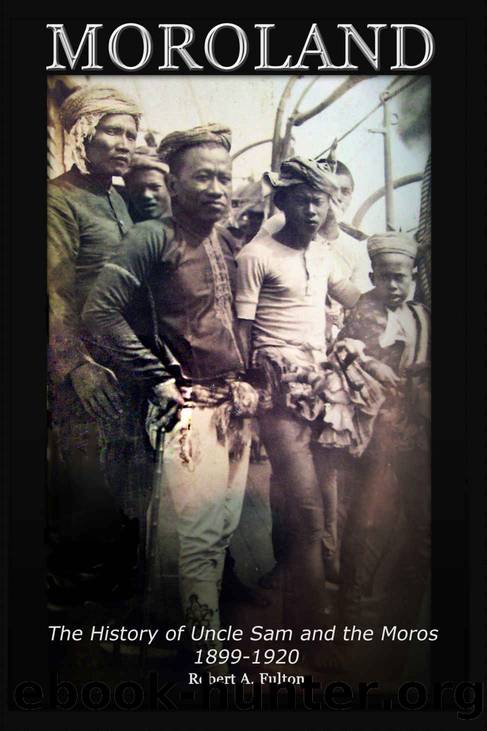MOROLAND: The History of Uncle Sam and the Moros 1899 - 1920 by Robert A. Fulton

Author:Robert A. Fulton [Fulton, Robert A.]
Language: eng
Format: epub
Publisher: Tumalo Creek Press
Published: 2007-09-29T16:00:00+00:00
* * * *
Miss Alice Roosevelt
The relaxation of tensions came just in time since out of necessity the priority in Moro Province had dramatically changed to a single-minded focus on a state visit by a genuine member of American royalty. âPrincess Aliceâ was coming. Some in the press used the title with sarcasm, but most meant it with affection and admiration for Miss Alice Roosevelt, the young, witty, intelligent, attractive, oldest daughter of the President. Alice was the only child from Rooseveltâs first marriage, named after her mother, who died from complications resulting from her birth. The First Daughter, slender and with chiseled and delicate features, mirrored the ideal Gibson Girl looks of the period and sported an incredible wardrobe.
Shortly after her coming-out party in 1902, she was featured on cover after cover of popular magazines, a large number of which ended up adorning menâs dormitory walls at universities and colleges. But the press and public were mesmerized not just by her looks, but rather her borderline rebellious personality, pithy comments, and at times outrageous conduct. She rode horses as recklessly as her father did, loved driving the newfangled automobiles at high speeds, smoked cigarettes and cheroots in public, kept a snake as a pet, carried a small pistol (an expert shot), and hung out with the âjet setâ long before there were jets. When a friend of her father complained that he was not keeping a short enough leash on his high-spirited daughter, Roosevelt was said to reply, âI can either run the country or I can attend to Alice, but I cannot possibly do both.â[312] Among the reasons Leonard Wood had been so concerned about maintaining peace during his absence from Moro Province was a series of letters he had received from Roosevelt on preparations for Taftâs first return visit to the Philippines. It was intended that the first daughter would have a central role.
In early 1905, Taft was not only Secretary of War but was filling in as the ad hoc Secretary of State, due to John Hayâs debilitating illnesses. Despite Rooseveltâs pre-Presidential and overly romanticized notions of militarism and foreign expansion, once he became Chief Executive, his views had undergone a dramatic transformation. He was becoming one of the most fervid practitioners of balance-of-power, real politic foreign policy to ever grace the office â a 180-degree contrast to McKinleyâs idealism.
In his annual message to Congress in December of 1904, Roosevelt warned of the inherent dangers of pursuing ambitious foreign policies while failing to back them up with adequate force, particularly naval. He had become uneasy with the increasing hostility among the major world powers and alarmed by the RussoâJapanese War. He was attempting to get both parties to the negotiating table and formulating a solution to end the hostilities that would also recognize and ensure the U.S. national interest in maintaining stability in Asia. He had dispatched a number of military observers to watch and analyze the RussianâJapanese conflict (among them Captain John J. Pershing), and what he was hearing was disturbing.
Download
This site does not store any files on its server. We only index and link to content provided by other sites. Please contact the content providers to delete copyright contents if any and email us, we'll remove relevant links or contents immediately.
| Africa | Americas |
| Arctic & Antarctica | Asia |
| Australia & Oceania | Europe |
| Middle East | Russia |
| United States | World |
| Ancient Civilizations | Military |
| Historical Study & Educational Resources |
Cat's cradle by Kurt Vonnegut(13868)
Pimp by Iceberg Slim(12931)
Underground: A Human History of the Worlds Beneath Our Feet by Will Hunt(11257)
4 3 2 1: A Novel by Paul Auster(11049)
The Radium Girls by Kate Moore(10907)
American History Stories, Volume III (Yesterday's Classics) by Pratt Mara L(4825)
Perfect Rhythm by Jae(4621)
Wiseguy by Nicholas Pileggi(4586)
The Fire Next Time by James Baldwin(4343)
Paper Towns by Green John(4169)
A Higher Loyalty: Truth, Lies, and Leadership by James Comey(4033)
Pale Blue Dot by Carl Sagan(4001)
The Mayflower and the Pilgrims' New World by Nathaniel Philbrick(3914)
The Doomsday Machine by Daniel Ellsberg(3731)
Too Much and Not the Mood by Durga Chew-Bose(3694)
Killers of the Flower Moon: The Osage Murders and the Birth of the FBI by David Grann(3609)
The Borden Murders by Sarah Miller(3590)
The Sympathizer by Viet Thanh Nguyen(3481)
Killing England by Bill O'Reilly(3455)
